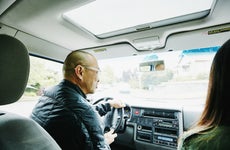Standard vs. nonstandard car insurance: What you need to know

The Bankrate promise
At Bankrate, we strive to help you make smarter financial decisions. To help readers understand how insurance affects their finances, we have licensed insurance professionals on staff who have spent a combined 47 years in the auto, home and life insurance industries. While we adhere to strict , this post may contain references to products from our partners. Here's an explanation of . Our content is backed by Coverage.com, LLC, a licensed entity (NPN: 19966249). For more information, please see our .
Key takeaways
- Nonstandard car insurance is insurance for drivers who present a greater risk to insurers, making it more expensive than standard insurance.
- New drivers, those with poor driving history, a lapse in coverage or a foreign driver’s license could be considered high-risk drivers.
- Shopping around with multiple carriers may help high-risk drivers get the best rates on nonstandard car insurance.
Most people will never need nonstandard auto insurance, but it is an option for drivers who are deemed high-risk or who have been denied standard car insurance. To be designated high-risk, drivers have usually racked up serious infractions like multiple speeding tickets, at-fault accidents or a DUI. Getting caught driving without insurance or being denied insurance because of a poor credit score (in most states) could also force drivers to seek out nonstandard car insurance. Bankrate’s insurance editorial team outlines standard vs. nonstandard auto insurance and the potential differences in cost and coverage options.
What type of drivers might need nonstandard auto insurance?
Nonstandard insurance was created for high-risk drivers unable to obtain a standard car insurance policy. But who is considered high risk? Auto insurers typically qualify the following drivers as nonstandard or high-risk:
- New drivers: Young drivers and inexperienced drivers are often considered riskier to insure because they have a greater likelihood of being involved in accidents.
- Foreign drivers: A visitor or temporary resident may not be eligible for standard auto insurance.
- Drivers with a coverage lapse: Failing to maintain continuous auto insurance makes drivers riskier to insure.
- Drivers with a recent history of incidents: Speeding tickets, car accidents or a DUI conviction could flag a driver as nonstandard. The severity, recency and frequency of the incidents, plus the insurance company’s comfort with these types of risk, can affect whether drivers with incidents on their record are eligible for standard car insurance.
- Drivers required to carry an SR-22: Drivers who had their license suspended or revoked may have to file an SR-22 certificate as proof they are carrying the required minimum amount of auto insurance coverage needed in their state.
The scenarios above could all potentially cause an auto insurer to refuse to offer standard auto insurance coverage—or to offer standard coverage at a much higher rate.
How is nonstandard car insurance different from standard insurance?
Nonstandard car insurance covers higher-risk drivers who may no longer qualify for standard coverage. The biggest differences between standard vs. nonstandard auto insurance are cost and choice. Nonstandard car insurance is typically more expensive and not all insurance companies offer it.
Purchasing nonstandard insurance works the same way as buying standard coverage. To find the best price, it’s a good idea to shop around and compare car insurance rates. Since premiums for nonstandard insurance are typically higher—and because all car insurance companies weigh multiple factors differently to calculate premiums—shopping around could help you find a more affordable premium. Once you choose a carrier, you can purchase a policy. If you are required to file an SR-22, you can ask the insurer to file it with the state on your behalf as proof that you are properly insured.
How are auto insurance premiums determined?
Auto insurance premiums are determined the same way whether you get standard or nonstandard insurance coverage. Insurance carriers use multiple factors to determine how much you pay for car insurance.
These factors (which can vary by state) may include:
- Your ZIP code (in most states)
- Prior insurance history
- Driving record of all household members
- Claims history of all household members
- Age (in most states)
- Gender (in most states)
- Vehicle make and model
In many states, your credit-based insurance score will also factor into your auto insurance premium. California, Hawaii, Massachusetts and Michigan ban or restrict credit scores as a rating factor for car insurance.
As far as the carrier you choose, the same level of coverage could cost more or less. Some nonstandard auto insurance companies specialize in high-risk car insurance, which may help you save on premiums. Insurers also rate incidents differently, such as at-fault accidents and speeding tickets, using proprietary algorithms to calculate premiums.
Frequently asked questions
-
-
Many of what are often considered some of the best car insurance companies, like Geico and Progressive, offer nonstandard car insurance. Although these are national insurers, several smaller or regional providers, like Safe Auto and Bristol West, also write nonstandard insurance. In some cases, these providers might offer more competitive rates, so you may want to request quotes in order to find the most affordable policy for you.
-
A car insurance company may cancel your coverage or choose to nonrenew it. If this is the case, you will need to find car insurance elsewhere. Finding a nonstandard insurance company may be your best option if you were nonrenewed because of an incident such as a DUI conviction. Nonstandard carriers may be more willing to work with you and may provide an SR-22 certificate (if required) proving you are legally insured.
-
If you have a nonstandard auto insurance policy, you may be eligible for standard coverage after a major violation has fallen off your driving record or you have maintained car insurance for six months or longer. Typically, insurance companies want to see that you can drive safely and maintain car insurance.
Guidelines vary by each standard insurance company, and you may be eligible for standard coverage earlier, or you may need to keep nonstandard coverage for longer. Time frames will vary depending on the rules of the standard company you are considering.
-
While being considered a high-risk driver can narrow your options, there are still likely to be several providers that will offer you coverage. Nonstandard car insurance is generally more expensive than standard insurance, but some companies specialize in high-risk drivers and offer more competitive rates than others. When looking for affordable rates, experts recommend shopping around between several companies to see which will offer you the best deal on the car insurance you need.
-
The length of time you’re considered a high-risk driver depends on the insurance company. In most cases, insurers look at your driving history from the past three to five years, so be prepared to pay more for insurance for at least a few years. This variability also highlights the importance of shopping around for car insurance since you might find a provider that only deems you high risk for three years rather than five. In the meantime, you may be able to alleviate some of the financial burden by requesting multiple quotes and comparing car insurance rates to find the best deal for your situation.
-
Related Articles



